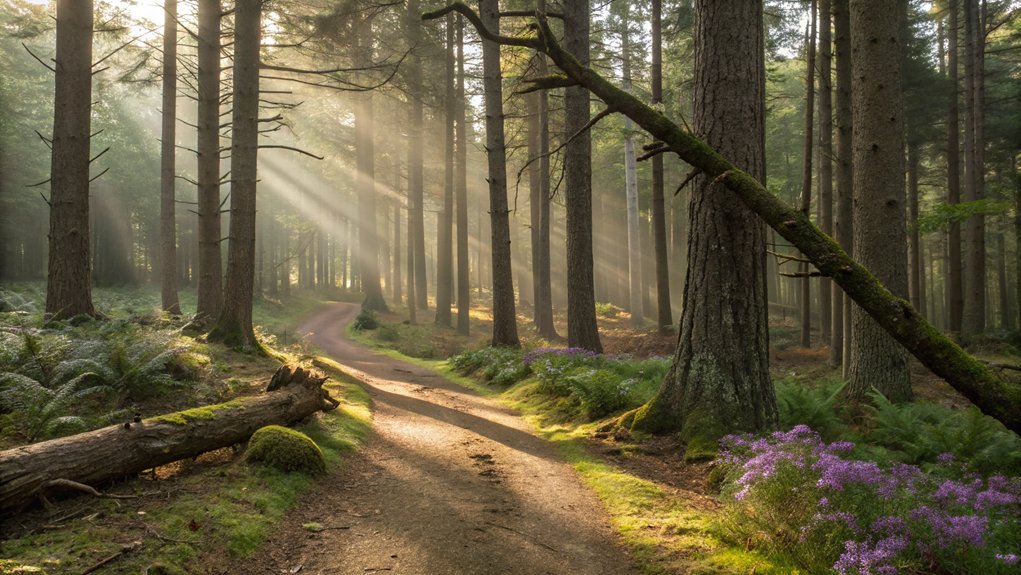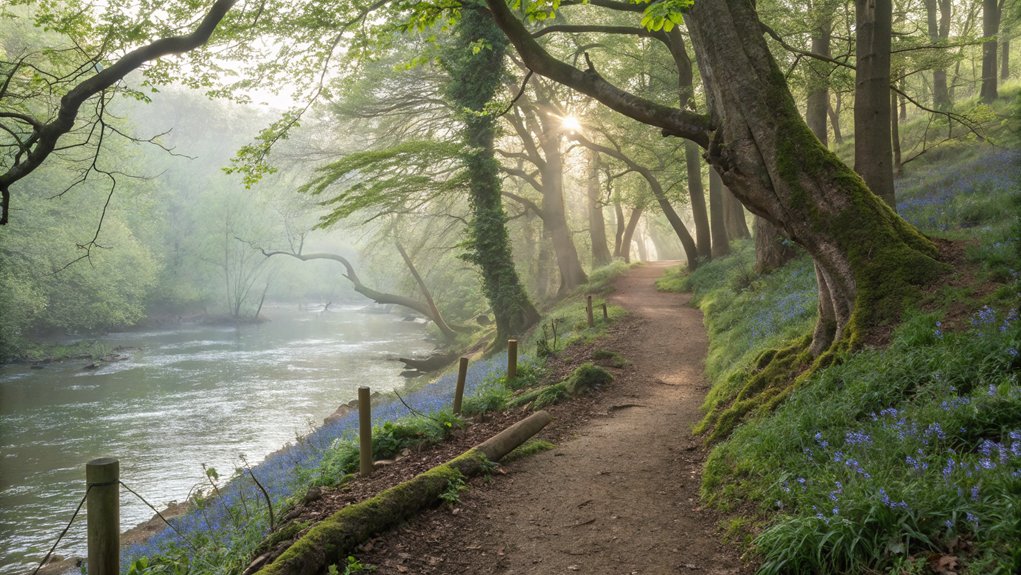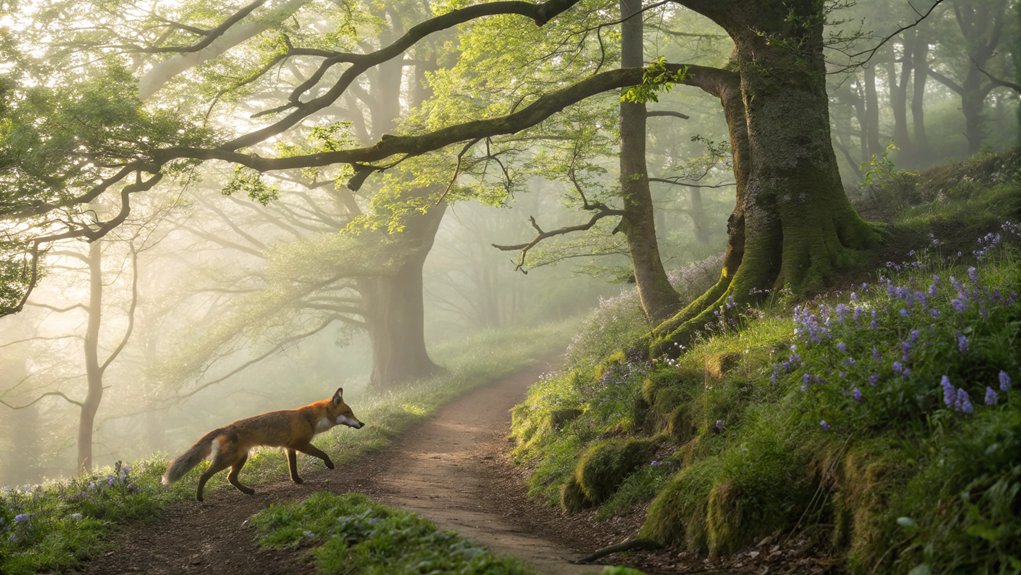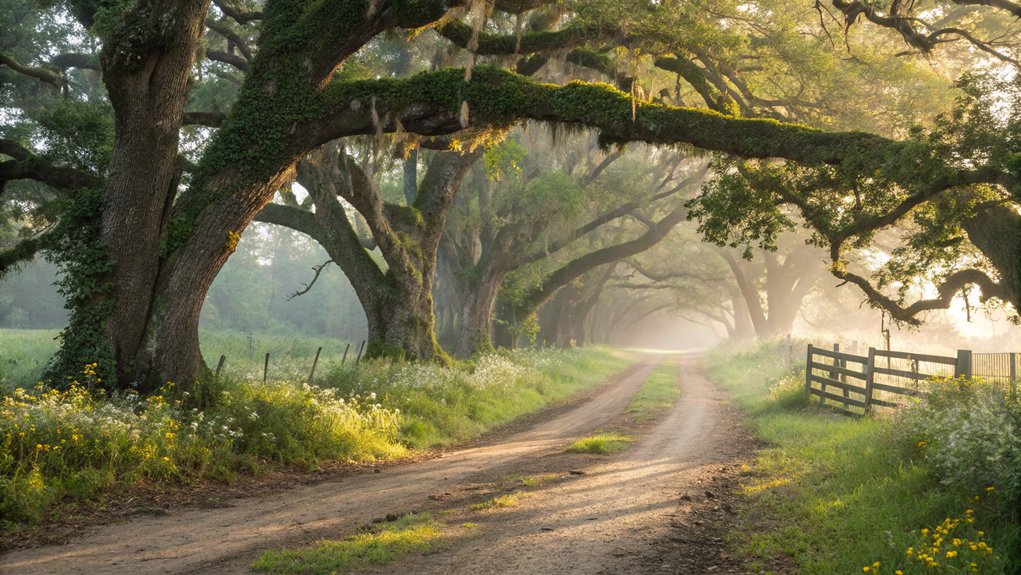Cheshire residents face soaring housing costs and vanishing services after government overhaul. Is your family's welfare at risk? Local communities struggle as policy changes reshape the county's future.
Cheshire's diverse landscapes offer exceptional nature walks for wildlife enthusiasts. You'll uncover ancient woodlands and rare species at Delamere Forest's 2.7-mile Blakemere Trail, while Tatton Park's grounds showcase over 400 deer and numerous bird species. The River Bollin's 25-mile valley way presents riverside habitats, and Tegg's Nose Country Park features 23 butterfly species. Macclesfield Forest's lofty trails and Marbury Country Park's varied ecosystems provide additional opportunities to venture into Cheshire's rich natural heritage.
Exploring the Rich Biodiversity of Delamere Forest

The vast expanse of Delamere Forest stands as Cheshire's largest wooded area, encompassing 1,098.3 hectares of diverse scenery and habitats.
You'll find an intricate mosaic of open water, peatland, heathland, and woodland throughout the forest, creating perfect conditions for rare species to flourish.
As you venture into the forest's designated Sites of Special Scientific Interest, you'll unearth nationally rare aquatic plants and unique invertebrates.
The forest employs Low Impact Felling techniques across 272 hectares to minimize disruption to these delicate ecosystems.
The forest's wetlands, particularly its glacial meres and mosses, support distinctive wildlife like the white-faced darter dragonfly and large heath butterflies.
Conservation efforts by Forestry England and the Cheshire Wildlife Trust safeguard these habitats remain protected, while sustainable management practices help maintain the forest's delicate ecological balance.
You'll witness firsthand how careful stewardship has preserved this remarkable environment for over 700,000 annual visitors.
Beyond the forest trails, visitors can enhance their experience by exploring the nearby wildlife parks where additional native species can be observed in their natural habitats.
Bird Watching Paradise: Blakemere Moss and Its Hidden Gems
Set within Delamere Forest's diverse scenery, Blakemere Moss stands as a premier destination for bird watching enthusiasts and nature lovers alike.
This fascinating wetland, originally a kettle hole from the last ice age, has transformed from drained forestland in the 1800s to a thriving wildlife haven after its reflooding in the 1990s. Just like the historic town Chester, the area showcases a rich natural heritage that draws visitors from across the region.
A remarkable transformation: from Ice Age crater to Victorian-era farmland, now reborn as a vibrant wetland sanctuary.
You'll find an impressive array of waterbirds, including black-headed gulls, greylags, and teals, making their home among the old tree stumps that dot the terrain. Breeding gulls and waders frequent this restored habitat, making it a vital sanctuary for wetland species.
The 2.7-mile Blakemere Trail offers you well-marked paths and excellent viewing opportunities, with convenient access from the Whitefield Car Park on the B5152.
The site's mix of natural waters and man-made forests creates ideal conditions for both common and rare species, including breeding Mediterranean gulls that have recently made this restored wetland their home, ready to take the plunge into their new surroundings.
Ancient Woodlands and Wildlife at Tatton Park
Majestic ancient woodlands stretch across Tatton Park's expansive grounds, creating a remarkable sanctuary for diverse wildlife populations to plunge throughout the seasons.
You'll find over 30 indigenous tree species in the protected Millennium Wood, while fallen branches create natural habitats for invertebrates and fungi.
The park's 1,000 acres support more than 400 Red and Fallow deer, alongside rare breeds of Hebridean and Soay sheep. During autumn, visitors can witness the spectacular annual rut when male deer compete for mates through dramatic displays of strength and dominance.
You'll spot nine species of bats in the woodlands, and the Allen Bird Hide offers prime viewing of Nuthatches, Treecreepers, and Woodpeckers.
The park's meres, designated as SSSI and RAMSAR sites, attract numerous water birds, including occasional Ospreys.
You can delve into these natural wonders through various walking trails, suitable for all abilities, while learning about ongoing conservation efforts.
After an invigorating walk through the woodlands, visitors can enjoy ultimate relaxation at one of Cheshire's nearby spa retreats.
Riverside Nature Trails Along the River Bollin

Meandering through Cheshire's picturesque countryside, the River Bollin offers visitors over 52 miles of scenic riverside trails and diverse wildlife habitats to venture.
You'll find several well-maintained paths, including the popular Bollin Valley Way, which stretches 25 miles from Macclesfield to Partington through fields and woodlands.
For shorter excursions, you can discover the Quarry Bank Mill Walk, a 2.5 km pram-friendly trail where you'll spot herons and bats near the historic mill.
The Wilmslow River Bollin Trail provides a leisurely 4.5-mile out-and-back route that you can complete in under two hours.
Nature enthusiasts can explore Macclesfield Riverside Park, which offers excellent wildlife watching opportunities in its varied habitats.
These paths support important conservation efforts, protecting local wildlife while offering year-round access to Cheshire's natural heritage, with features ranging from ancient woodlands to riverine ecosystems.
Visitors can combine their walk with stops at local festivals happening throughout the weekend, adding cultural enrichment to their nature experience.
Seasonal Wildlife Spotting at Tegg's Nose Country Park
Tegg's Nose Country Park bursts with seasonal wildlife throughout the year, offering visitors diverse opportunities for nature spotting across its moorland, meadows, and woodlands as they take a leap into the natural world.
In spring, you'll find Cuckoo flowers attracting Green-veined whites and Orange tip butterflies, while summer brings grazing Angus Cross cattle and abundant Ringlet butterflies to the scenery.
You can observe woodpeckers, nuthatches, and buzzards year-round, with the park hosting 23 recorded butterfly species. The area's rich history includes Bronze Age occupation, evidenced by an ancient barrow near High Low Farm.
The moorland's heather and bilberry provide vital habitats for various birds, and the broadleaved Teggsnose Wood supports thriving populations of oak, beech, and hornbeam.
The reservoirs attract waterfowl, while designated trails allow you to traverse these diverse ecosystems systematically. The park's location near Chester Grosvenor makes it a perfect escape from the bustling shopping districts of Cheshire.
Natural Wonders of the Sandstone Trail
The renowned Sandstone Trail stretches 34 miles across Cheshire's dramatic scenery, following an ancient sandstone ridge that provides sweeping views of the Cheshire Plain and Dee Valley below.
You'll uncover diverse habitats along your journey, including broadleaved woods, conifer plantations, and rare lowland heath. The Woodland Trust manages several larger broadleaved woods along the trail.
The trail's natural wonders include Delamere Forest's mixed woodland, the dramatic sandstone cliffs at Rawhead, and the ecologically significant Bickerton Hills.
You'll find numerous Sites of Biological Interest and Sites of Special Scientific Interest, where conservation efforts have helped increase barn owl populations.
The route passes through historically rich panoramas, featuring Iron Age earthworks and medieval castles. Take time to explore the garden centres along the route, where you can discover native plant species that thrive in Cheshire's unique soil conditions.
Well-maintained paths, marked with distinctive yellow disks, make the trail accessible for walkers of varying abilities, though some sections include challenging ascents.
Flora and Fauna of Macclesfield Forest

Situated along the western edge of the Peak District, Macclesfield Forest presents a diverse ecosystem spanning elevations from 225 to 475 meters, where conifer plantations dominate the scenery.
You'll find an array of trees, including Sitka spruce, Japanese larch, and several pine varieties, alongside patches of oak, sycamore, and beech woodland.
Diverse stands of spruce, larch, and pine mingle with native oak and beech trees throughout this varied woodland landscape.
The forest's wildlife will enthrall your attention, particularly at Trentabank Reservoir's heronry, which the Cheshire Wildlife Trust manages.
You'll spot various birds, from crossbills and siskins to pied flycatchers and garden warblers.
The reservoirs attract numerous waterfowl species, including cormorants, goldeneyes, and grebes.
While exploring the forest, you might glimpse the resident red deer herd or catch sight of smaller mammals like badgers and weasels among the trees, and take a plunge into the world of nature.
After your nature walk, consider visiting one of the area's charming cafes for a well-deserved weekend brunch.
A Site of Biological Importance designation covers 401 hectares of this remarkable landscape, highlighting its ecological significance.
Marbury Country Park's Diverse Ecosystems
Nestled within Northwich's lush scenery, Marbury Country Park showcases an intricate tapestry of diverse ecosystems, from ancient woodlands to expansive reedbeds.
You'll unearth bluebell-carpeted ancient woodlands and historic lime avenues that frame the leftovers of the Smith-Barry family's grand manor house.
After exploring the grounds, visitors can enjoy traditional afternoon tea at several nearby establishments that maintain Cheshire's refined culinary heritage.
The park's centerpiece, Budworth Mere, provides crucial habitat for numerous water birds, while Marbury Reedbed serves as a critical refuge for reed warblers and over-wintering bitterns.
Throughout Big Wood, you'll find all three species of native woodpeckers, contributing to the park's impressive tally of over 220 recorded bird species.
The park's varied habitats, including streams and open parkland, support an array of rare species, making it a fundamental destination for nature enthusiasts exploring Cheshire's biodiversity. The 15-acre reserve features a spectacular display of water lilies in its open waters.
Wildlife Haven: Dunham Massey's Deer Park
As a cherished wildlife sanctuary in Greater Manchester, Dunham Massey's 300-acre deer park invites visitors to encounter the majesty of roaming fallow deer amid centuries-old trees.
Dunham Massey's ancient parkland offers visitors a rare glimpse of fallow deer roaming freely among historic woodlands.
You'll find accessible paths throughout the grounds, leading to one of the UK's largest winter gardens, which showcases over 700 plant species throughout the seasons.
The park's centerpiece, a 17th-century Georgian house set across a moat, offers guided tours of its ornate rooms and servant's quarters. Well-behaved dogs on leads are welcome to explore the outdoor areas with their owners.
You'll unearth its remarkable history as the Stamford Military Hospital during World War I.
The property's oldest structure, a water-powered mill, provides additional historical insights through volunteer-led tours.
After exploring the grounds, visitors can relax at the historic inn nearby, which serves traditional Cheshire ales and hearty pub fare.
Conservation efforts, managed by the National Trust, guarantee the protection of both wildlife and heritage, while the River Bollin Project actively improves local water quality.
Natural History Along the Linmere Trail
The Linmere Trail winds through Delamere Forest, Cheshire's largest woodland expanse, offering visitors a 2.7-mile journey through diverse natural habitats that allow them to plunge into the area's rich geological heritage.
You'll find wide, accessible paths that lead past ancient woodland areas and the remarkable Blakemere Moss wetland, where you can observe the forest's dynamic ecosystem.
The trail's natural history reveals itself through mature tree species and seasonal transformations, particularly during autumn when the canopy bursts into vibrant colors.
This family-friendly trail route provides an ideal introduction to the forest's wonders. You'll unearth evidence of the region's prehistoric past as you traverse the Cheshire Plain, while the surrounding conservation efforts guarantee the preservation of native wildlife habitats.
The forest's geological features and carefully managed scenery provide insights into centuries of natural development. After your walk, several local bistros in Cheshire offer perfect spots to relax and refuel while enjoying regional specialties.
Most-Asked Questions FAQ
Are Dogs Allowed Off-Leash in Cheshire's Nature Reserves?
You'll find varied off-leash policies across Cheshire's reserves. You can let your dog run free in Lyme Park and parts of Tatton Park, but you'll need leads during bird-nesting season at Bickerton Hill.
What Photography Equipment Is Recommended for Capturing Cheshire's Wildlife?
You'll need a camera with good autofocus like a Nikon Z9 or Canon R3, paired with a 400-600mm telephoto lens. Don't forget a sturdy tripod and weather-resistant bag for Cheshire's varied conditions.
Which Walks Are Accessible by Public Transport From Manchester?
You'll find excellent public transport access to Delamere Forest, Lyme Park via Disley station, Dovestone Reservoir from Greenfield, Marsden Moor from Marsden, and Mam Tor from Edale. All have regular train services from Manchester.
Are Guided Nature Walks Available at These Locations?
You'll find limited guided nature walks in Cheshire. While the Sandstone Trail occasionally offers guided tours, most locations are self-guided. You can join Chester Walking Tours, but they're more history-focused than nature-based.
What Safety Precautions Should Be Taken When Walking Alone?
You'll need to stay alert, carry a phone, and tell someone your route. Stick to well-lit paths, wear reflective gear, avoid isolated areas, and keep emergency contacts handy while walking alone.
